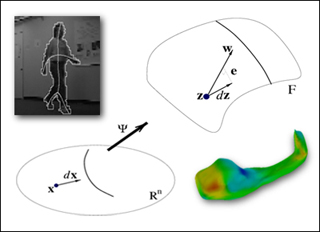
Example object representations. (Images by Prof. Polina Golland.)
Instructor(s)
Prof. Polina Golland
MIT Course Number
6.881
As Taught In
Spring 2005
Level
Graduate
Course Description
Course Features
Course Description
Most algorithms in computer vision and image analysis can be understood in terms of two important components: a representation and a modeling/estimation algorithm. The representation defines what information is important about the objects and is used to describe them. The modeling techniques extract the information from images to instantiate the representation for the particular objects present in the scene. In this seminar, we will discuss popular representations (such as contours, level sets, deformation fields) and useful methods that allow us to extract and manipulate image information, including manifold fitting, markov random fields, expectation maximization, clustering and others.
For each concept -- a new representation or an estimation algorithm -- a lecture on the mathematical foundations of the concept will be followed by a discussion of two or three relevant research papers in computer vision, medical and biological imaging, that use the concept in different ways. We will aim to understand the fundamental techniques and to recognize situations in which these techniques promise to improve the quality of the analysis.


